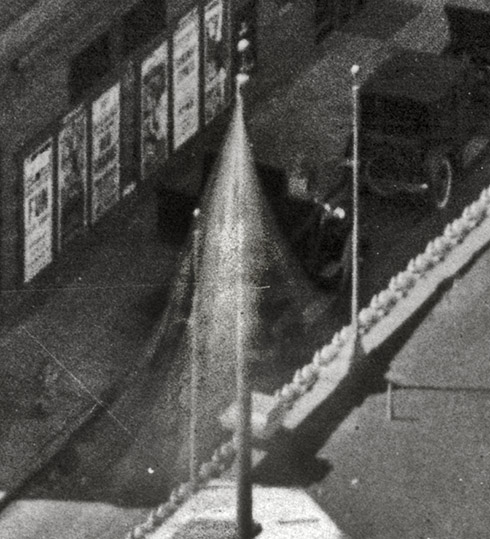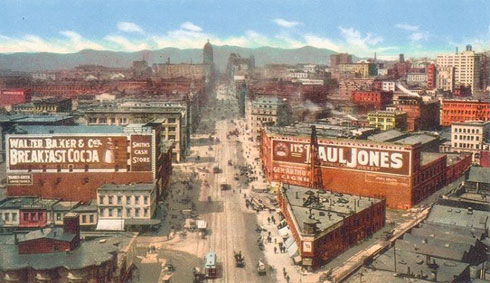


Framed or unframed, desk size to sofa size, printed by us in Arizona and Alabama since 2007. Explore now.
Shorpy is funded by you. Patreon contributors get an ad-free experience.
Learn more.

- Lost in Toyland
- And without gloves
- If I were a blindfolded time traveler
- Smoke Consumer Also Cooks
- Oh that stove!
- Possibly still there?
- What?!?
- $100 Reward
- Freeze Frame
- Texas Flyer wanted
- Just a Year Too Soon
- WWII -- Replacing men with women at the railroad crossing.
- Yes, Icing
- You kids drive me nuts!
- NOT An Easy Job
- I wonder
- Just add window boxes
- Icing Platform?
- Indiana Harbor Belt abides
- Freezing haze
- Corrections (for those who care)
- C&NW at Nelson
- Fallen Flags
- A dangerous job made worse
- Water Stop
- Passenger trains have right of way over freights?
- Coal
- Never ceases to amaze me.
- Still chuggin' (in model form)
- Great shot
Print Emporium
Market Street: 1926

San Francisco ca. 1926. "Market Street from Ferry Building." Note the backwards Owl Cigar signage. 8x10 nitrate negative, photographer unknown. View full size.
Russ Building?
Emporis says the Russ Building was finished 1927-- think that's it under construction, midway between 225 Bush and the Mark Hopkins?
[The building under construction is the Western Women's Club headquarters (a.k.a. "San Francisco Women's Club") at 609 Sutter. In the 1940s it became the Marines' Memorial Club and Hotel. - Dave]

A truly historic photo
This documents the last time there were parking spaces on Market Street in San Francisco.
One of My Faves From Shorpy
This is a great one! The guys painting the Maxwell House sign! Bernstein's Fish Grotto!
Why don't we name things "Grotto" anymore? Grottos had a good run but seemed to peter out by the 80's.
Owl Cigars 5 cents M.A. Gunst & Co.
Moses A. Gunst One of the most beloved men in the history of San Francisco.
General Offices
The building one block up on the left still stands. It was the headquarters of the Southern Pacific Railroad where I kept things running on Third Trick (midnights). My office was just past the balcony on the 6th floor facing Market Street. There was no need for air conditioning; you just opened the windows. We used the windows to get rid of stale coffee too - not too many pedestrians late at night. Being there the last working day of the year was interesting. Office workers had a strange habit of throwing small calendar pages (the kind that you flipped a page each day) out the windows before going home. It was almost like a ticker tape parade. A legion of street cleaners would have it all swept away by the next morning. Looking out the widows at the Hyatt Regency Hotel across the street might be interesting too - especially when a convention was in town.
Short city
Nearly all of the low-rise buildings in that photo are gone now, wiped out between 1960-90. The Loma Prieta earthquake of 1989 was used as a feeble excuse for condemning the few remainders, including one in which I had been working just a couple years earlier. Fortunately, most of the vintage 10-12 storey buildings survive.
Hotel Terminal
You can check out any time you like but you can never leave.
Spectral Christmas tree
There appears to be something swinging/spinning from the pole like a loose mast halyard in the right foreground, causing a Christmas tree-like artifact. Must have been a breezy day and a bright rope!
[The thing on the flagpole is the Stars and Stripes. There another one at the next street corner. - Dave]

19 Years Earlier
The same view taken while the City was still smoldering in 1906.
Perfectly readable in the rearview
I bet that sign was designed for those people stuck waiting to turn into traffic off the side road. Anyone turning onto it would be past before seeing it, but if you're stuck waiting for traffic to clear and happen to glance in your mirrors it would be perfectly readable. How about an Owl?
[Generally speaking, 1920s cars did not have rearview mirrors, and the sign itself looks to be quite a bit older. Even in 1925, the majority of eyeballs passing by would have been on streetcars. While the sign might have reflected off the windows of the building across the street, I suspect eye-catching novelty was the strategy. - Dave]
Foster and Kleiser billboard
The Maxwell House billboard bears the maker's name on top, Foster and Kleiser.
According to Wikipedia, that firm evolved into the current-day Clear Channel Outdoor Holdings, "the oldest outdoor advertising company in the United States as their roots trace back to the three companies that merged into the current incarnation: Foster & Kleiser (1901-1986), Patrick Media Outdoor (1986-1995) and Eller Media Company (1959-1997)."



























On Shorpy:
Today’s Top 5